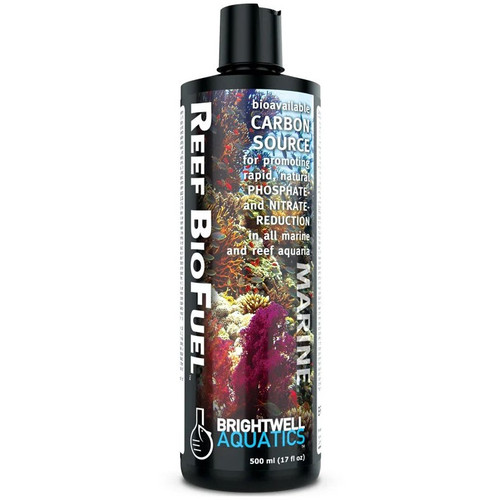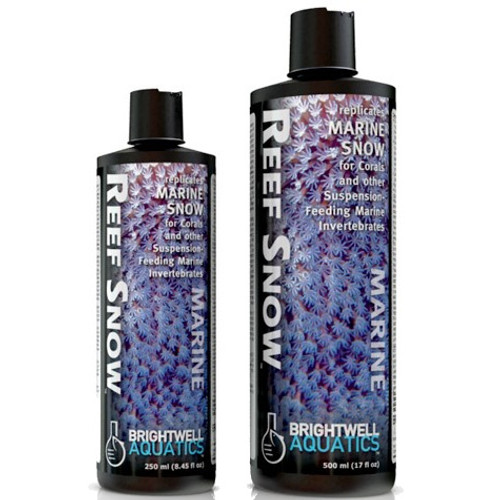Brightwell Aquatics NeoMarine Reef & Marine Salt Mix, 50 gal.
As you have read on the outside of this container of NeoMarine, we make the claim that it is so close in composition to natural seawater that marine organisms cannot tell the difference. How can we make this claim if the product does not provide every element present in natural seawater? The answers are not as complicated as one might think, and may be addressed in three separate but very important aspects: 1.) the nature of the elements present; 2.) their concentrations with respect to average natural seawater parameters; 3.) the quality of ingredients utilized and the means in which the salt is produced. These points are addressed individually below.
Product Introduction
As you have read on the outside of this container of NeoMarine, we make the claim that it is so close in composition to natural seawater that marine organisms cannot tell the difference. How can we make this claim if the product does not provide every element present in natural seawater?
The answers are not as complicated as one might think, and may be addressed in three separate but very important aspects: 1.) the nature of the elements present; 2.) their concentrations with respect to average natural seawater parameters; 3.) the quality of ingredients utilized and the means in which the salt is produced. These points are addressed individually below.
First, all major elements are present in NoMarine, however only minor and trace elements known to undergo biological and/or chemical interactions (e.g. depletion) in natural seawater are included. What this means is that there is a specific change (decrease) in the concentration profile of the element measured in the surface waters where life is concentrated; such elements are believed to interact with marine life and/or with other substances present in the water, and these elements are considered to exhibit “non-conservative” behavior.
Elements that do not exhibit these characteristics do not apparently interact with marine life or these other substances (at least as far as current analytical methods can discern); they are not likely necessary for the continued health or existence of marine organisms.
It follows that these elements are not required for success with a marine aquarium; in fact, if added they would gradually accumulate with time. Because of this, they may be omitted from the salt mix and the savings in raw materials and production procedures passed on to the aquarist.
Second, the comparison table on the outside of this package indicates that, when mixed to a specific gravity of 1.024 g/cm3, the concentrations of elements present are extraordinarily close to those observed in natural seawater; in fact, with only one exception (chloride), all major, minor, and trace elements present are in the proportions to one another that they are in natural seawater.
The natural seawater concentrations of elements listed are taken from current data compiled by oceanographers, and the formula is adjusted as analytical methods are improved and new data becomes available. These changes are so minute that they will not noticeably alter the performance of the salt or the appearance of aquarium inhabitants; we simply want the concentrations of elements present to remain as close to those found in natural seawater as possible.
Third, as with all Brightwell Aquatics water care products, we use the very highest purity ingredients available, period. This means that the majority of individual ingredients in NoMarine are of USP or ACS grade, the highest levels of purity in existence. We do not cut any corners when it comes to what goes into our products. Additionally, we manufacture our salt mix on-site under very strict environmental conditions, ensuring the maximum degree of quality and accuracy to our formulation, and every container of NoMarine is lot numbered for quality control.
This formula has undergone extensive testing and has produced very impressive results. Livestock from every common family of ornamental marine organisms has been maintained in water prepared with this formula without incident, many of them reproducing freely when they had not done so in aquaria maintained with other salt brands.
If you have purchased this package, used a portion of it, and find that the salt falls short of your expectations, please do not hesitate to contact us. We want you to use this salt and be 100% satisfied with it. We are confident that NoMarine Salt Mix is the best such product on the market because we have formulated it to contain everything needed by marine life in precise natural seawater concentrations, and because we have paid such close attention to all pertinent details of purity and manufacturing. We thank you for choosing Brightwell Aquatics as your supplier of marine aquarium salt, and wish you the best of success with your aquaria.
A Brief Discussion of Specific Gravity (Density) and Salinity
Specific gravity is a measurement of density, and the relationship that it has with salinity is dependant upon water temperature. Oceanographers generally agree that the average salinity of the world’s oceans is ~35.0‰, however the salinity of water in some areas may be considerably higher. This is largely a result of the balance between evaporation and influx of freshwater in specific areas and/or bodies of water; the higher the rate of evaporation and/or the lower the relative volume of freshwater influx, the higher the average salinity tends to be.
The Red Sea is a prime example of this: essentially surrounded by desert and with very little exchange of water between itself and neighboring water bodies, the average salinity tends to be quite high relative to that of other tropical marine environments; areas of the Red Sea may exceed 40‰ at times. For the most part, however, salinity in tropical areas tends to fall between 35 – 37‰, and this is a sensible range to maintain within marine aquaria.
Instructions and Guidelines
Each 138.8 grams of NoMarine will increase the specific gravity of 1 US-gallon of purified water to approximately 1.024 g/cm3. To obtain a higher or lower specific gravity when preparing water, divide the desired value by 1.024 and then multiply this number by the volume of water (in gallons) being prepared, then multiply this value by 138.8 to obtain the mass of salt required (in grams) to be added (example: if target SG is 1.021 in 5.0 gallons of water: 1.021 ÷ 1.024 = 0.998; 0.998 × 5.0 = 4.985; 4.985 × 138.8 g = 691.92 g, as opposed to 694.0 g required to increase SG in 5.0 gallons to 1.024 g/cm3). If not using an accurate scale to measure salt, dissolve approximately 4 oz., or half a cup, of salt mix in each gallon of purified water to obtain a target specific gravity between 1.021 – 1.024 g/cm3, and adjust as needed by adding more salt or water to increase/decrease specific gravity, respectively.
It is strongly recommended that water purified via reverse osmosis and/or deionization be used for seawater preparation. Add the required amount of water and salt to a clean container such as a large plastic pail and mix it thoroughly with a submersible pump. Always use an accurate hydrometer or (preferably) refractometer to determine the specific gravity of prepared seawater. Ensure that the water temperature matches that of the established aquarium (use a submersible heater if necessary).
Although the prepared water may be used immediately upon reaching the desired specific gravity and pH (and temperature), it is recommended that at least one hour (and preferably several hours) of mixing be allowed to pass before adding the water to an established aquarium; this extra time enables gas formed during the salt dissolution to escape, further stabilizing pH.
Water changes in all marine aquaria should be made weekly to help maintain the natural seawater ionic ratios. The addition of supplements (which add elements that are affected by both biological and chemical interactions (non-conservative elements), as well as others that are not affected by these processes (conservative elements) and therefore accumulate with time unless removed with water changes), the depletion of various non-conservative elements, loss of salt to the external environment through water spraying, interaction of various elements with organic matter in the aquarium, and removal of elements via chemical filtration all alter the ionic ratio of the water. Weekly water changes of at least 5% of the total volume of water in the system will help counter these processes and provide a more stable environment for ornamental marine organisms. Note that if an aquarium is established with an inexpensive synthetic salt blend lacking adequate concentrations of non-conservative elements, additional money must be spent on supplements to correct the deficiencies before any animals are introduced to the system; these supplements may contain conservative elements that further alter the ionic ratio of the water. In light of these facts, it can be said that purchasing an inexpensive salt blend saves no money in the long run and does not encourage the health of livestock.
Switching from your present salt mix to NoMarine: Stability of water chemistry is one of the most important aspects of successfully maintaining a marine aquarium. Therefore, sudden changes in water chemistry, such as when making high-volume water changes with water that has different chemical characteristics (no matter how slight the differences are), can have significant negative impacts on the livestock; even if they appear to be healthy initially, they may very well be found in poor appearance or even deceased a few hours later. This is often the case when manufacturers alter their salt formulation (either by accident or design) without informing their customers; what would seem to be a routine water change with a salt that has been used for months or even years can result in disaster.
It is imperative when changing from your current brand or formula of salt to a new one that the transition be gradual. We strongly recommend that the maximum water changed when switching to a new salt mix not exceed 5% of the total system volume (taking the water in sumps and displacement of water due to rock and bottom substrate into account) per 7-day period. This maintains relative stability in the water chemistry and has a much lower impact on aquarium inhabitants than does changing larger volumes. While it may take 5 – 6 months to completely switch over to a new formula (when doing a weekly 5% water change; water changes with less frequency will increase the time to complete transition accordingly), this should not be viewed as a nuisance, but rather as insurance that the livestock will make the transition smoothly and without illness or death. Considering the degree of care that goes into maintaining most marine aquaria, this method of careful transition is well worth the effort.
If you have recently changed from another brand of marine aquarium salt to this one, we would love to see “before and after” photos of the system after it has been established. Contact us for details on photo submission, and a chance to have your photos featured on our website.
Item No. SA-BA-NMAR50
1 Review
-
Great midrange salt
This salt is a mid-range price with a low high-end quality I've never had issues with this salt except one bag that had lower alkalinity. Other than that all the measurements check out for me












